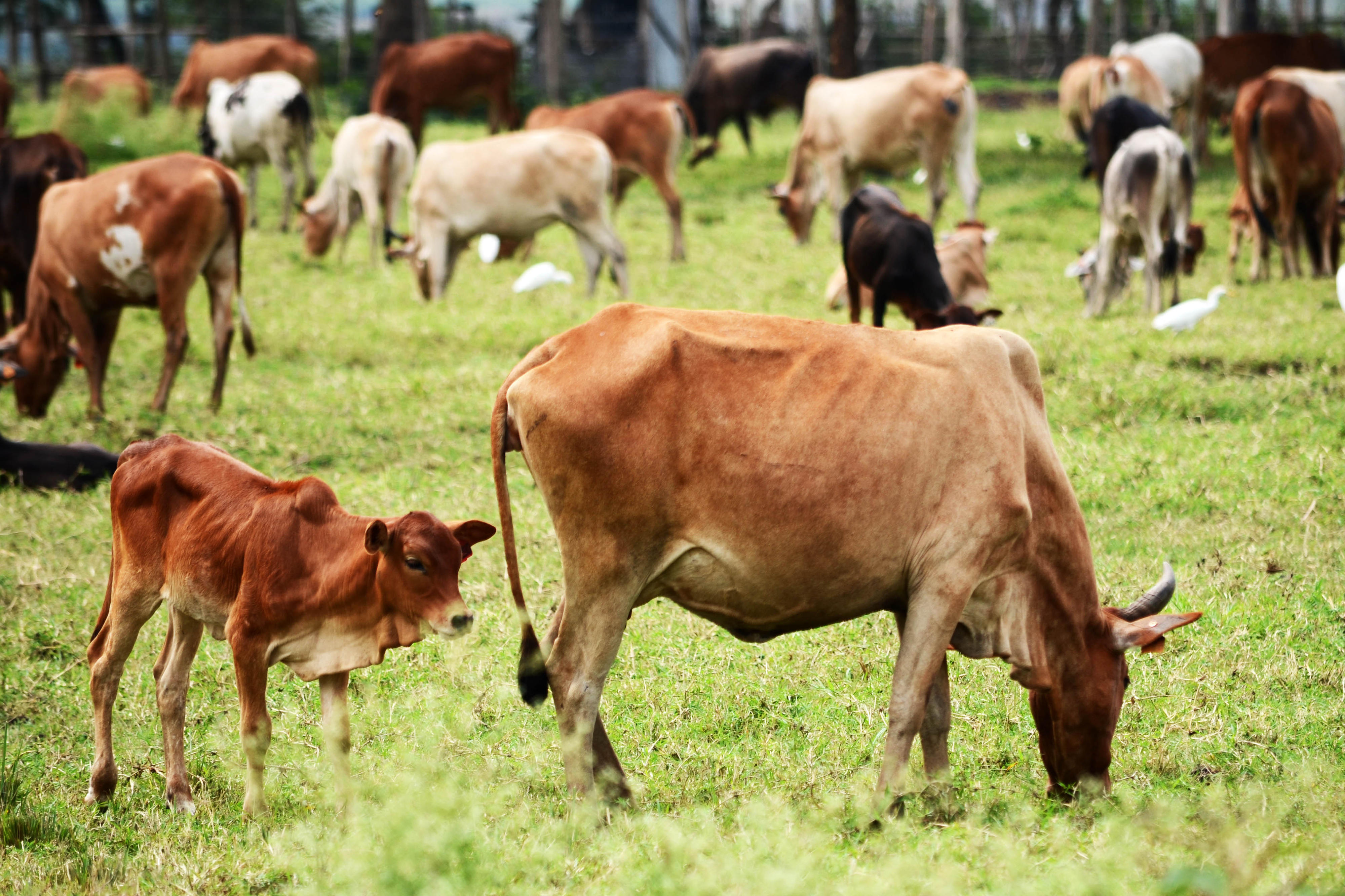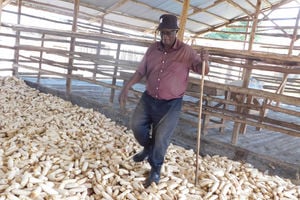
Kanunu (right) feeding his dairy cows during milking for better results. PHOTO | FILE
In the world of dairy farming, optimising the nutrition of dairy cows is a crucial aspect that directly influences their productivity and overall health. The lactation cycle is a fundamental factor significantly affecting a cow’s nutritional requirements.
As dairy cows progress through various lactation stages, their nutritional needs evolve, demanding tailored diets to support their milk production, body condition, and reproductive performance.
This article will explore the intricate relationship between lactation cycles and dairy cow nutrition. We will explore the unique nutritional demands of each lactation stage and discuss strategies for ensuring optimal nutrition, ultimately benefiting both the cows and the dairy farmers.
Early lactation (0–70 days after calving)
During this period, milk production increases rapidly, but feed intake may not meet the energy requirements for milk production. Adjusting the milking ratio is important, and gradually increasing grain intake can boost nutrient intake while avoiding off-feed problems.
Protein is critical, and the ration should contain at least 19 percent crude protein to support milk production. Providing top-quality forage, adequate amounts of protein, and considering fat supplementation can enhance nutrient intake.
Peak dry matter intake (second 10 weeks after calving)
Cows should be maintained at peak production and ensure proper feed intake. Limiting excessive grain intake and maintaining high-quality forage is crucial. Potential issues during this period include a rapid decline in milk production, low-fat tests, silent heat, and ketosis.
Mid- to late lactation (140 to 305 days after calving)
This stage is easier to manage as milk production declines, and cows require less feed to replace body tissue. Grain feeding should meet milk production requirements and replace weight lost during early lactation. Young cows need additional nutrients for growth.
Dry period (60 to 14 days before calving)
A well-managed dry cow programme is essential to optimise milk yield and prevent metabolic issues. Dry cows’ diets should meet nutrient requirements, including body maintenance, fetal growth, and weight replacement. Adequate calcium, phosphorus, vitamins, and trace minerals should be provided.
Transition period (14 days before calving)
The close-up dry cow feeding programme is critical in transitioning dry cows to the lactation ration. Introducing grain helps shift the rumen bacteria population, and some ingredients from the lactation ration can ease the ration change stress. Proper management includes grain adaptation, increased protein, limited fat intake, and stimulation of rumination.
Late lactation
Late lactation represents the final stage of the cow milking cycle before they enter the dry period. During this phase, both milk production and feed intake gradually decline. As a result, rations with high protein and energy content become less critical compared to earlier stages.
In late lactation, the focus shifts towards supporting the cow’s weight gain as the fetus grows and replenishing the adipose tissue lost during early lactation.
Although maintaining adequate nutrition is still important, the emphasis is not on maximising milk production but on ensuring the cow’s overall health and preparing her for the upcoming dry period.
Balancing energy and protein intake
Finding the right balance between energy and protein intake during early lactation is crucial to support milk production and cow health.
Research suggests a higher energy density diet with adequate protein levels positively impacts milk yield and composition. A balanced diet ensures cows have enough energy for milk synthesis while providing essential amino acids for protein production.
Mineral supplementation
In mid-lactation, mineral supplementation is crucial in enhancing dairy cows’ reproductive performance. Providing appropriate levels of minerals, such as calcium and phosphorus, in the grain mix (approximately 1 percent) supports optimal reproductive function.
Additionally, maintaining salt intake at 0.5 percent of the ration’s dry matter or 1 percent of the grain mix is important. Adequate supplementation of minerals and a balanced diet can contribute to improved reproductive outcomes in mid-lactation dairy cows.
Feeding strategies
To prevent metabolic disorders in late lactation, providing a balanced diet with appropriate energy and nutrient levels is important. Avoid over-conditioning cows and manage body weight. Monitor calcium and phosphorus intake to prevent milk fever. Control energy intake to prevent fatty liver syndrome. Implement proper feeding practices and ensure adequate access to feed and water to support cow health and prevent metabolic issues.
Effects of dietary fibre
Dietary fibre is crucial in early lactating cows’ rumen fermentation and milk production. Adequate fibre in the diet promotes rumen health and maintains a stable rumen environment. It stimulates the growth of beneficial rumen bacteria, leading to efficient fibre digestion and volatile fatty acid production.
Fibre fermentation also helps maintain a proper rumen pH, preventing acidosis. Additionally, dietary fibre positively influences dry matter intake, nutrient utilisation, and milk production in early lactating cows, contributing to overall productivity and performance.
Optimising amino acid
Achieving an optimal amino acid balance is crucial for mid-lactation dairy cows. Research indicates that a balanced amino acid profile in the diet positively affects milk production and composition. Providing the right combination and proportion of essential amino acids ensures efficient protein synthesis and utilisation, improving milk yield and quality.
Formulating rations with adequate lysine, methionine, and other essential amino acids can enhance milk protein synthesis and overall cow performance. The transition or close-up dry cow feeding programme is vital in preparing dry cows and springing heifers for the lactation ration while preventing metabolic issues.
Introducing grain two weeks before calving is crucial to shift the rumen bacteria population from forage digestion to a mix of forage and grain digestion. Adding some ingredients from the lactation ration during this period eases the ration change stress post-calving.
Essential in milk production
After calving, a dairy cow should be fed three kilogrammes of concentrates (dairy meal) per day depending on individual production. The animals may be challenged further by increasing their dairy meal rations for up to an optimal level.
Dairy meal should be fed after milking so that the cow remains standing until the teat canal closes. This helps to avoid teat infection and mastitis.
Farmers should supplement their dairy cows with yeast either in feeds or drinking water to boost milk production.
Yeast fed to a dairy cow improves feed digestibility, increases feed intake and overall performance and productivity.
Yeast extracts increases the number and activity of beneficial bacteria leading to increased rate of ruminal fermentation and a subsequent increase in net energy.
As more organic matter is fermented per unit time, the animal is able to consume more dry matter which also increases net energy.
As the number of beneficial bacteria increases, there is subsequent increase in microbial protein, which when combined with increased net energy leads to high milk production.
Stimosol Oral is a well-balanced combination of yeast, vitamins, organic acids and minerals.
Mineral supplements should be provided as they are essential in milk production, they improve fertility, reduce incidences of retained placenta and also contributes to development of strong bones in the growing foetus.
Granular mineral salts should be mixed with feeds in a feeding trough or fed with the concentrates. It may be necessary to moisten the granular mineral licks to prevent dusting during licking as this predisposes the cows to respiratory problems.
Provide mineral salts at a rate of 150g for every 5 litres of milk produced, and an extra 60g for every 5 extra litres.
Free lick intromin mineral block should be availed at all times. Wholesome drinking water must be available all the time.
In the world of dairy farming, optimising the nutrition of dairy cows is a crucial aspect that directly influences their productivity and overall health.
The lactation cycle is a fundamental factor significantly affecting a cow’s nutritional requirements. As dairy cows progress through various lactation stages, their nutritional needs evolve, demanding tailored diets to support their milk production, body condition, and reproductive performance.








